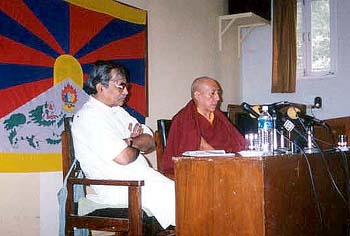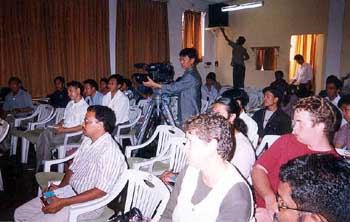"Prof Samdhong Rinpoche's on Hind Swaraj"
(DIIR Hall, Dharamshala | August 19, 2002)

Prof Samdhong Rinpoche Delivering His Speech
At the outset, I must express my appreciation and gratitude to Friends of Tibet (INDIA) for doing many things for the Tibetans-in-exile at the grassroot level who are not yet really prepared themselves for freedom movement, particularly the freedom movement under the leadership of His Holiness the Dalai Lama, for whom commitment to a Non-Violence is uncompromising. Under the leadership of His Holiness the people of Tibet quite sincerely engaged themselves for the freedom of Tibet for the past more than fifty years. Of course during the last 50 years we have achieved great deal and today, we are now almost at a stage to take off, but for our weaknesses which I feel is not very easy to remove in a short span of time.
The greatest weaknesses, which we are facing, are two things. One: our commitment to Non-Violence under the leadership of His Holiness the Dalai Lama, is quite sincere. I do not doubt the sincerity of the people but the understanding and the culture of Non-Violence is not able to evolve within ourselves. Second: Such dichotomy with us is that we are committed to ourselves to a genuine democratic system, but the people have not been able to evolve and develop democratic culture, culture for Democracy within ourselves. So we find some kind of struggle, and it is absolutely indispensable to develop an understanding of the culture of Non-Violence and a culture of Democracy if we want to achieve the success.
This problem has been understood by Friends of Tibet (INDIA) and now they are quite sincere about doing something about it. They continuously and persistently go around the Tibetan communities and talk with them, have dialogues with them about the Non-Violence, about freedom struggle and particularly the Gandhian concept of freedom and the Gandhian concept of Non-Violence.
Gandhian concept of Non-Violence is extremely apt for us because this concept of Non-Violence is accepted and practiced by His Holiness, our leader and he says that the Gandhian interpretation of Non-Violence is correct or the real one. And therefore we must study it, we must try to understand what the concept is? Why Gandhi's teachings necessarily fall under Buddha's teachings?
Buddha was a monk, Buddha was a spiritual teacher and the entire teaching was woven around just for spiritual upliftment. He did not care to give a social upliftment, he did not care to give a social, philosophical or political meaning to it, because Buddha's teachings of Non-Violence was in the context of spiritual practice. We may be able to understand it in Buddha's own word.
Many past Tibetan rulers were not able to understand the Buddha's concept of Non-Violence in the context of social and political freedom. For that reason I always say although the Tibetans have until now claimed that we have a combination of Dharma and politics, the 'Chosi-Sungdel' but it had never happened in real sense until the present XIV Dalai Lama.
The past leadership always thought that a certain degree of violence, power and repression is needed if one needs to run a country or govern a nation and therefore Tibet in-spite of being a Buddhist country and in spite the title 'the combination of Dharma and polity' we have never been able to have a military free nation. Not only Tibet, there are many Buddhist countries today, who until now have not been able to do away with their military force, with their weapons and with their ordinary defence system of today. In that context unless we read Gandhi's teachings we will never be able to understand it in the context of social and political teachings of Buddha's Non-Violence.
I deeply appreciate to have this series of workshops on the text of 'Hind Swaraj'. Gandhi had written and spoken voluminously. The collected works published until now is more than 300 volumes, almost Buddha's teachings of the 'Kangyur' which has 108 volumes. Gandhi never cared for consistency. He was always doing experiments and each day he had something new to say.
So you'll find a great deal of inconsistencies and differences. And you'll know that Buddha's teachings, each word of Buddha's teachings cannot be taken on face value of the world, we call it 'nizar' and 'niarth.' We have to interpret many things, because of inconsistency. Yet certain basic principles which cannot be compromised, for example the four outlines of Buddha's philosophy, that have to be consistent in every teaching and every word. Similarly the 'Hind Swaraj' of Gandhi's basic teachings and even after around 30 years, he did not find anything-needing revision. That means this is pure and basic teaching, therefore we must learn, we must read this great book.
This is the only treatise, a text which is almost 100% relevant, and Gandhi interpreted in our own context, as Dr Mani has very rightly mentioned in his introduction, that wherever 'India' and 'British' are mentioned or used in this book, if you substitute them by 'Tibet' and 'China,' the whole book is entirely relevant to the Tibetan issue.
I am seriously studying this book for the last 12 years. I knew about it for quite a long time but I was not able to study it seriously in depth until 1992 when I came to Dharamsala to work in the parliamentary affairs. I had a chance to interact with some of the Gandhians and our dialogues and our interactions were centered on 'Hind Swaraj'. At that time I realised I must re-study and re-read 'Hind Swaraj' seriously. Since then I kept on reading it. I found that whatever doubts and whatever questions aroused in my mind in the context of Tibet issue, I am able to find a suitable answer. I always go to 'Hind Swaraj' and read it more carefully, I always find the correct answer to my doubts, to my questions from this small book. Since then I am carrying it around with me wherever I go.
For me 'Hind Swaraj' is equally important as that of Dhammapada and in many ways more important than Dhammapada, because my understanding of Dhammapada is through 'Hind Swaraj'. When I do not have any exposure to Gandhi's teachings my understanding of Buddhism was general and Dhammapada's importance was very limited.
After reading Gandhi's many works particularly 'Hind Swaraj' my understanding of Buddhism and Non-Violence has immensely widened and became practical in every word. It may be social, political and economic. Each one of the questions of life is dealt with correct answers. So this is the philosophy of life and this is the philosophy of spirituality in full time.
I mentioned it before also, at a similar kind of workshop in Sarah, where chapter by chapter how they are related to the Tibetan situation, is more clearly demonstrated by Dr Mani. I would like to sum up with few things, which might perhaps facilitate to redo this workshop with Rajiv Bhai in the coming three days.
Today the whole world is in the influence of the material. The various forms of materialistic outlook and the tension between materialistic approach and the spiritualistic approach or in other words idealism and materialism, this debate and dialogue remained in the world for centuries, for many years. Perhaps it may not end. For centuries people are divided. People who are leading the life of civil society so to say, many to govern a nation or state. Those people are considered to be assigned to work in the materialistic field and their spiritual practice is a kind of part time job. They are not expected that they would achieve a great deal in their spiritual field. They just think that the spiritual aspect would be done by the other segment of the society.
Many people who opt for spiritual pursuit, mostly renounce the civil societies, get into monasteries, become monks and rather become dependant on civil society for their livelihood and their persuit for the duality of material attainment and salvation or nirvana. Buddha had said at many times particularly in his Mahayana teachings and Vajrayana teachings, that worldly appearance and spiritual appearance can be combined in one's individual life. But his teaching was never demonstrated by anyone. It was Gandhi who has demonstrated, who said that the materialistic approach cannot keep you anything worthwhile for your spiritual objectives and not only the materialistic approach can give you full worldly life, that was Gandhi's
teaching. For leading a full and satisfying worldly life, you need the understanding of spirituality, the inner life. This is really a very unique teaching perhaps not very many of Gandhian followers very carefully understood it.
The Tibetan people who by tradition proclaim that they advocate the combination of spirituality and worldly life, and if we have to prove this as reality, as a pragmatic thing, the only way is to adopt the Gandhian teaching, only then we might be able to say that we are following a path of combination of Dharma and polity.
If this basic concept is properly analysed and understood, then the spirituality and materialistic do not need to be opponents or opposite things. It can be complementary to each other, the whole material life can be converted into a spiritual life, that is absolutely and easily possible and that is very clearly demonstrated and explained throughout this book -- 'Hind Swaraj.'
'Hind Swaraj' basically is known for two sharp criticisms; one on the modern civilisation and the other on missionary and the industrial society. These two criticisms are extremely important. This is all the discourse. Today the underpinning of criticism is very shallow. A Buddhist must know the way of criticisms, because the whole of Buddha's teaching is a form of dialogue and is not a form of preaching or sermon. Buddha's sutra goes through an analytic dialogue. Through those dialogues, they arrive to a consensus.

Listening to Prof Samdhong Rinpoche
Above is a speech given by Prof Samdhong Rinpoche in Dharamshala on August 19, 2002 during the 'Hind Swaraj Reading' organised by the Friends of Tibet (INDIA) in association with Swarajpeeth.